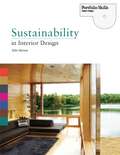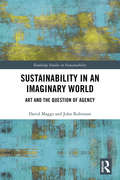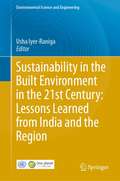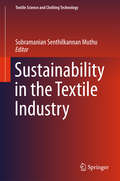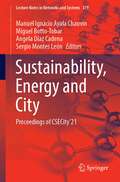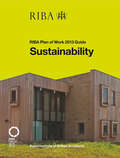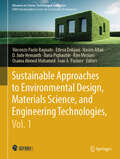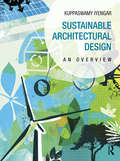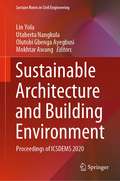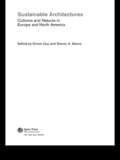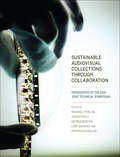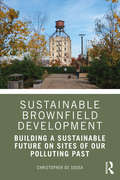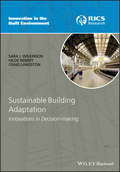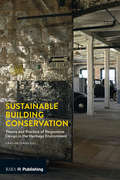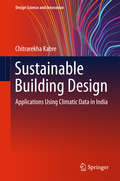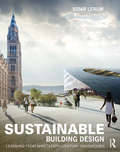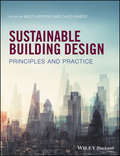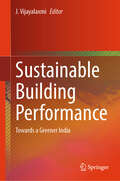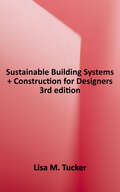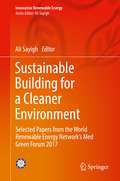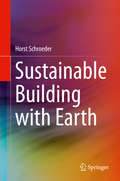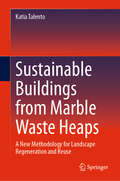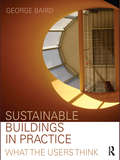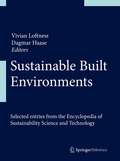- Table View
- List View
Sustainability in Interior Design
by Siân MoxonThe environmental impact of interior architecture and design practice is immense. This book highlights the need for designers to adapt the way they work and relearn lessons that have been lost. Contrary to many preconceptions, sustainable design can be sophisticated and stylish. And by its nature, a sustainable approach means considering the whole life cycle of a project and therefore improving the functionality, quality, human enjoyment and, in the long term, bringing real social and economic benefits. This book has examples, techniques, and historical and contemporary case studies, all supported by useful resources and links. A comprehensive reference book for anyone wanting to work in this area, Siân Moxon aims to introduce the ideas behind sustainability to design students while they are formulating their understanding of the industry, encouraging and inspiring them with positive, creative and practical alternatives.
Sustainability in Interior Design (Portfolio Skills)
by Siân Moxon Sian MoxonThe environmental impact of interior architecture and design practice is immense. This book highlights the need for designers to adapt the way they work and relearn lessons that have been lost. Contrary to many preconceptions, sustainable design can be sophisticated and stylish. And by its nature, a sustainable approach means considering the whole life cycle of a project and therefore improving the functionality, quality, human enjoyment and, in the long term, bringing real social and economic benefits. This book has examples, techniques, and historical and contemporary case studies, all supported by useful resources and links. A comprehensive reference book for anyone wanting to work in this area, Siân Moxon aims to introduce the ideas behind sustainability to design students while they are formulating their understanding of the industry, encouraging and inspiring them with positive, creative and practical alternatives.
Sustainability in an Imaginary World: Art and the Question of Agency (Routledge Studies in Sustainability)
by John Robinson David MaggsSustainability in an Imaginary World explores the social agency of art and its connection to complex issues of sustainability. Over the past decade, interest in art’s agency has ballooned as an increasing number of fields turn to the arts with ever-expanding expectations. Yet just as art is being heralded as a magic bullet of social change, research is beginning to throw cautionary light on such enthusiasm, challenging the linear, prescriptive, instrumental expectations such transdisciplinary interactions often imply. In this, art finds itself at a treacherous crossroads, unable to turn a deaf ear to calls for help from an increasing number of ostensibly non-aesthetic fields, yet in answering such prescriptive urgencies, jeopardizing the very power for which its help was sought in the first place. This book goes in search of a way forward, proposing a theory of art aiming to preserve the integrity of arts practices within transdisciplinary mandates. This approach is then explored through a series of case studies developed in collaboration with some of Canada’s most prominent artists, including internationally renowned nature poet Don McKay; Italian composer and Head of Vancouver New Music, Giorgio Magnanesi; the renowned Electric Company Theatre, led by Kevin Kerr; and finally through a largescale multimedia installation aiming to reimagine the relationship between climate, culture, and human agency. Sustainability in an Imaginary World will be of great interest to students and scholars of arts-based research fields, sustainability studies, and environmental humanities.
Sustainability in the Built Environment in the 21st Century: Lessons Learned from India and the Region (Environmental Science and Engineering)
by Usha Iyer-RanigaThis book follows on previous works addressing sustainable development research in the Asia-Pacific region. It mainly focuses on India, a country currently facing immense challenges in the form of climate change, rapid urbanisation, and population pressures in its journey to help achieve the Sustainable Development Goals. Expecting to surpass China in terms of population in the near future, India needs to develop its own solutions in order to uphold its commitments under the Paris Agreement. This book makes a contribution in that direction by presenting case studies on various aspects of the built environment, from education to managing cities, procurement, and considerations for a circular economy. The papers gathered here offer a vital resource for government policymakers, educators, and current and future professionals, equipping them with the knowledge and expertise they need in order to overcome today’s complex challenges in the built environment.
Sustainability in the Textile Industry
by Subramanian Senthilkannan MuthuThis book examines in detail key aspects of sustainability in the textile industry, especially environmental, social and economic sustainability in the textiles and clothing sector. It highlights the various faces and facets of sustainability and their implications for textiles and the clothing sector.
Sustainability, Energy and City: Proceedings of CSECity’21 (Lecture Notes in Networks and Systems #379)
by Miguel Botto-Tobar Angela Díaz Cadena Sergio Montes León Manuel Ignacio Ayala ChauvinThis book constitutes the proceedings of the 1st Congress in Sustainability, Energy and City (CSECity’21) held in Ambato, Ecuador, on June 28–29, 2021, proudly organized by Universidad Tecnológica Indoamerica in collaboration with GDEON. The CSECity brings together experts that promotes the dissemination of advances in sustainability, urbanism, energy, and industry research through the presentation of keynote conferences. In CSECity, theoretical, technical, or application works that are research products are presented to discuss and debate ideas, experiences, and challenges. Presenting high-quality, peer-reviewed papers, the book discusses the following topics: Energy sustainability Information and knowledge management Information technologies Innovation, technology, and society Software and systems modeling Software systems, architectures, applications, and tools Sustainable energy and the city.
Sustainability: RIBA Plan of Work 2013 Guide
by Sandy Halliday Richard AtkinsSustainability is part of a brand new series providing must-read practical guidance to running efficient and successful projects using the new RIBA Plan of Work 2013. Each guide takes a core project task – in this case those associated with achieving sustainable design and construction - and explains the essential activities required at each stage. Concise and easy to use with a consistent format these guides provide the ultimate quick reference support at your desk or on-site. An authoritative ‘how to’ full of pragmatic advice, examples and in-text features such as ‘hints and tips’ that illuminate best practice and clever solutions. Designed to be used on all projects – large and small – and across all types of procurement, they are task rather than role-oriented acknowledging that a variety of people take on these responsibilities. They are also invaluable for architectural students at Part 3 who are getting to grips with the realities of practice.
Sustainable Approaches to Environmental Design, Materials Science, and Engineering Technologies, Vol. 1 (Advances in Science, Technology & Innovation)
by Ivan A. Parinov D. Jude Hemanth Hasim Altan Ilaria Pigliautile Etleva Dobjani Vincenzo Paolo Bagnato Rim Meziani Osama Ahmed MohamedThis book highlights the sustainable innovation in environmental design, materials science, and engineering technologies. It provides a multidisciplinary approach to addressing contemporary challenges in creating resilient, efficient, and health-promoting built environments. With contributions from leading experts, the book covers a wide range of topics including architectural design, urban planning, sustainable materials, and renewable energy technologies. Also, it explores sustainable solutions and innovative practices across a range of disciplines essential for the future of our built environment. It examines architectural design, urban planning, and infrastructure, highlighting approaches that promote resilience and efficiency in urban settings. The book aligns with sustainable development goals, providing practical insights and strategies to achieve global sustainability targets. This book focuses on sustainable methodologies in material sciences, exploring the latest advancements in eco-friendly materials and their applications in construction. The integration of renewable energy technologies is thoroughly examined, showcasing how these innovations can reduce environmental impacts and enhance energy efficiency. Additionally, the book addresses the crucial theme of environmental integration and impacts, presenting comprehensive studies on the intersection of engineering technologies with environmental sustainability. Furthermore, it is an indispensable resource for professionals, researchers, and students dedicated to fostering sustainable development across multiple fields. It offers valuable guidance on implementing sustainable practices to create a healthier and more sustainable world.
Sustainable Architectural Design: An Overview
by Kuppaswamy IyengarThis book is a guide to a sustainable design process that moves from theory, to site and energy use, to building systems, and finally to evaluation and case studies, so you can integrate design and technology for effective sustainable building. Kuppaswamy Iyengar shows you how to get it right the first time, use free energy systems, and utilise technologies that minimize fossil fuel use. Each chapter has a sustainable design overview, technical details and strategies marked by clear sections, a summary, and further resources. Heavily illustrated with charts, tables, drawings, photographs, and case studies, the book shows technologies and concepts integrated into cohesive project types, from small and large office spaces to single and multiuse residences, hospitals, schools, restaurants, and warehouses to demonstrate implementing your designs to meet clients' needs now and for the future. Includes an overview of alternate assessment and evaluation systems such as BREEAM, CASBEE, GBTool, Green Globes alongside LEED, ECOTECT, energy 10, HEED and eQuest simulation programs. The guide reveals the importance of the building envelope—walls, superstructure, insulation, windows, floors, roofs, and building materials—on the environmental impact of a building, and has a section on site systems examining site selection, landscape design, thermal impact, and building placement.
Sustainable Architecture and Building Environment: Proceedings of ICSDEMS 2020 (Lecture Notes in Civil Engineering #161)
by Mokhtar Awang Utaberta Nangkula Lin Yola Olutobi Gbenga AyegbusiThis book presents articles from the International Conference on Sustainable Design, Engineering, Management, and Sciences (ICSDEMS 2020), held in Bali, Indonesia. It highlights recent advances in civil engineering and sustainability, bringing together researchers and professionals to address the latest, most relevant issues in these areas.
Sustainable Architectures: Critical Explorations of Green Building Practice in Europe and North America
by Steven A. Moore Simon GuyAs buildings are responsible for fifty per cent of CO2 emissions, their design has become the focus of intense technical scrutiny. Knowing how to build more technically efficient, or ecologically responsible, buildings, and being able to assemble the social resources to do so, requires different forms of knowledge and practice. There is wide contestation over the optimal pathways to greener buildings design and great diversity in practices of sustainable architecture.This volume brings together leading researchers from across the European Union and North America both to illustrate the diversity of practice and to provide a critical commentary on this key debate. The reader is provided with an introduction to competing perspectives on the sustainable architecture debate, international exemplars of differing practice and an overview of new theoretical and methodological resources for understanding and meeting the conceptual, social and technical challenges of sustainable architecture.
Sustainable Audiovisual Collections Through Collaboration: Proceedings of the 2016 Joint Technical Symposium
by Rachael Stoeltje Vicki Shively George Boston Lars Gaustad Dietrich SchüllerThe art and science of audiovisual preservation and access has evolved at breakneck speed in the digital age. The Joint Technical Symposium (JTS) is organized by the Coordinating Council of Audiovisual Archives Associations and brings experts from around the world to learn of technologies and developments in the technical issues affecting the long-term survival and accessibility of audiovisual collections. This collection of essays is derived from presentations made at the 2016 JTS held in Singapore and presents an overview of the latest audiovisual preservation methods and techniques, archival best practices in media storage, as well as analog-to-digital conversion challenges and their solutions.
Sustainable Brownfield Development: Building a Sustainable Future on Sites of our Polluting Past
by Christopher De SousaWhile industrial and chemical innovations have contributed extensively to human advancement, the darker part of their legacy has been the hundreds of thousands of polluted sites left behind. Governments at all levels have rallied to support the remediation and reuse of these land resources and put many of the nation’s brownfields back into productive use. This book presents two dozen brownfield projects in the United States that have incorporated sustainability, highlighting project features, best management practices, and lessons from the field regarding the underlying policies and practices that enabled these projects to be completed or, in some cases, stalled, altered or abandoned. The case studies represent an array of brownfield projects that aimed to go beyond conventional practice and include a range and variety of end uses (e.g., corner gas stations, industrial, office, residential, brightfields, green space, mixed-use and transit-oriented developments). The cases investigate site histories, planning and development and examine sustainability characteristics to understand how projects overcame the barriers to brownfield reuse and the implementation of sustainability features and derive a series of lessons learned, including innovative policies, programs, and/or funding mechanisms that helped make these projects work. Sustainable Brownfield Development will be of interest to developers, planners, consultants and community representatives interested in environmental policy, urban planning, community development, ecological restoration, economic development, and parks planning by providing direction and inspiration for those eager to erase the blight of the past and build a more sustainable future.
Sustainable Building Adaptation: Innovations in Decision-making (Innovation in the Built Environment)
by Sara J. Wilkinson Hilde Remøy Craig LangstonHow to adapt existing building stock is a problem being addressed by local and state governments worldwide. In most developed countries we now spend more on building adaptation than on new construction and there is an urgent need for greater knowledge and awareness of what happens to commercial buildings over time. Sustainable Building Adaptation: innovations in decision-making is a significant contribution to understanding best practice in sustainable adaptations to existing commercial buildings by offering new knowledge-based theoretical and practical insights. Models used are grounded in results of case studies conducted within three collaborative construction project team settings in Australia and the Netherlands, and exemplars are drawn from the Americas, Asia, Japan, Korea and Europe to demonstrate the application of the knowledge more broadly. Results clearly demonstrate that the new models can assist with informed decision-making in adaptation that challenges some of the prevailing solutions based on empirical approaches and which do not accommodate the sustainability dimension. The emphasis is on demonstrating how the new knowledge can be applied by practitioners to deliver professionally relevant outcomes. The book offers guidance towards a balanced approach that incorporates sustainable and optimal approaches for effective management of sustainable adaptation of existing commercial buildings.
Sustainable Building Conservation: Theory and Practice of Responsive Design in the Heritage Environment
by Oriel PrizemanThis book incorporates UK and international case studies and essays to identify the overlaps in the interests of energy and building conservation. The relevance and adjustments of qualitative and quantitative frames of reference are introduced, alongside the various expertise of the contributors: architects, designers, conservation consultants and academics. The second part of the book showcases sustainable domestic and non-domestic heritage projects, translating the preceding research into information that practitioners can use in their everyday work. The book will appeal to architecture students, newly qualified professionals and conservation architects and will enhance readers’ ambitions, so that they feel equipped and inspired to work with old buildings sensitively, creatively and sustainably.
Sustainable Building Design
by Chitrarekha KabreThis book bridges the gap between research and practice in the area of sustainable design of buildings, exploring the passive (climate-responsive) design and thermal behavior of buildings and ways to incorporate these enhancements in architectural and civil engineering practice. It presents climatic data and its analysis in a readily usable form and shows ways in which such data can be used to achieve passive (climate-responsive) and sustainable building design. The book presents case studies of sustainable building in each of five climatic zones of India. The book includes climatic data from 62 cities in India and describes how it can be synthesized in sustainable building design. The book can serve as a practical tool or handbook for architects, engineers, and designers, providing them with an understanding of the physical phenomena involved and a means for suitably implementing and applying passive (climate-responsive) design principles. It also offers a valuable resource for researchers, students, and policymakers working in the area of sustainable building design and construction.
Sustainable Building Design: Learning from nineteenth-century innovations
by Vidar LerumA twenty-first century renaissance is emerging in architecture. After a century of building designs characterized by high energy demand, low quality lighting and poor thermal comfort, the fundamental questions must be asked again: is there a better path to designing the most energy efficient, comfortable, functional and beautiful buildings for a sustainable future? While seeking solutions for the future, are there lessons to be learned from the best buildings of the past? Sustainable Building Design explores outstanding buildings and building designs of the twenty-first century, with an emphasis on the artistry of masters of architecture who came before. By dissecting and analyzing great public buildings of the nineteenth and twenty-first centuries, materials, techniques, and methods are discovered. This book presents the reader with clues and suggestions that will reveal the secrets of these buildings and by doing so provides the reader with a thorough understanding of how these architectural masterpieces work. Using photographs, drawings, sections, plans and diagrams which are painstakingly redrawn for consistency and clarity based on a wide range of documentation, Vidar Lerum compares works of architecture from the nineteenth and twenty-first centuries. The reader is presented with a careful analysis of each building, providing a compelling sourcebook of ideas for students and professional architects alike.
Sustainable Building Design: Principles and Practice
by Miles Keeping David ShiersAn inside view of how one of the world's leading architecture and engineering practice does business Sustainable Built Environments: Principles and Practice offers detailed, environmentally sound design solutions to a wide range of building engineering challenges. The text uses case examples and project data provided by engineers and designers at Arup Associates. It covers a broad range of relevant issues, with focused commentaries and explanations presented in an accessible format for use by students, busy practitioners and informed clients. Whilst this book stresses the importance of a unified approach to design, the text is divided into six principal chapters, each addressing an important aspect of sustainable architecture and engineering. These chapters (Master Planning, Transport, Energy, The Building Envelope, Environmental Services, and Materials) may be read on their own or in sequence as part of a narrative. Throughout the book, photographs, architectural and engineering drawings and diagrams, examples, and other data illustrate the case studies. Numerous web links are provided to additional information. This inspirational book: Focuses on the work of Arup Associates, the award winning architectural and engineering practice Uses real-life examples of functioning buildings and structures to provide information and guidance on the development of sustainable solutions Is packed with informative illustrations Sustainable Built Environments: Principles and Practice is a unique text that will inform and inspire architects and engineers, as well as students of those disciplines, around the globe.
Sustainable Building Performance: Towards a Greener India
by J. VijayalaxmiThis book highlights the evaluation and assessment of various aspects of sustainable buildings to achieve a greener future. India, at the 26th session of the United Nations Framework Convention on Climate Change (COP 26) in November 2021, announced its target to achieve net zero by 2070. Being an emerging economy, the number of buildings required is expected to grow exponentially. Hence, there is a need for a pragmatic and realistic path to reach the committed goal of reaching net zero. To participate in a global transition to clean, low-carbon energy systems, which aligns with Sustainable Development Goal (SDG) 11 (Sustainable Cities and Communities) and Climate Action (SDG 13), it is important to research cooling strategies for a tropical country like India. The India Cooling Action Plan clearly acknowledges the deep connection between SDGs, especially SDG 13. Passive cooling strategies require a micro-level understanding of the impact of building materials on the thermal performance of buildings. To contribute to the global transition to clean, low-carbon energy systems, it is essential to assess India's energy retrofit policies, the use of low-carbon building materials, energy-efficient building design to enhance passive cooling, ways to mitigate outdoor heat, and learnings from vernacular architecture and biophilic building design. This book explores how viable solutions such as these could address some of India's most pressing challenges, including energy efficiency, climate resilience, and environmental sustainability, contributing to India's progress towards SDG 3 (Good Health and Well-being), SDG 7 (Affordable and Clean Energy), SDG 9 (Industry, Innovation, and Infrastructure), and SDG 13. The research papers presented in this book are the result of systematic research conducted after identifying a research gap through the latest review of literature. They present new knowledge that can aid in making performance-based design decisions. All these aspects are analyzed using real-time data obtained through field studies. The book is a valuable resource for professionals and researchers working in energy efficiency and sustainable buildings.
Sustainable Building Systems and Construction for Designers: Bundle Book + Studio Access Card, Third edition
by Lisa M. TuckerAuthor Lisa M. Tucker covers topics in a holistic approach, from the structural (site consideration and foundations) to the experiential (indoor air, acoustics, and safety), making a clear case for interior design professionals to understand their moral responsibilities to people and the environment, and to follow sustainable building practices. Now in its third edition, the award-winning Sustainable Building Systems and Construction for Designers has been updated to reflect current CIDA accreditation standards and include recent industry trends related to interior construction, such as security and well-being. Additionally, a complete set of new case studies has been commissioned. Line drawings, color photography, and sample student work join together to support student learning on this essential and timely topic. New to this Edition: -Updated with CIDA Standards 2018 -Expanded content on security, resilience, plumbing, and well-being design trends -Complete set of 7 new case studies -First edition to include STUDIO with self-assessment questions and flashcards and Instructor Resources including an instructor's guide and PowerPoint slides
Sustainable Building for a Cleaner Environment: Selected Papers from the World Renewable Energy Network's Med Green Forum 2017 (Innovative Renewable Energy)
by Ali SayighThis book contains selected papers presented during the bi-annual World Renewable Energy Network’s Med Green Forum aimed at the international community as well as Mediterranean countries. This forum highlights the importance of growing renewable energy applications in two main sectors: Electricity Generation and the Sustainable Building Sector. In-depth chapters highlight the most current research and technological breakthroughs, covering a broad range of renewable energy technologies and applications in all sectors – for electricity production, heating and cooling, agricultural applications, water desalination, industrial applications and for the transport sectors.
Sustainable Building with Earth
by Horst SchroederThis book provides an insightful overview of the current state of earth building. The author approaches the subject from the perspective of the building material's life cycle, featuring in-depth explanations of the cycle's individual steps: extraction and classification of construction soil; production of earth building materials and earthen structures; planning, construction and renovation of earth buildings; and demolition and recycling of earthen structures. This unique resource provides examples of sophisticated earth building projects and illustrates the diverse applications of earth as a building material. Compared to conventional mineral building materials, earth possesses particularly positive ecological qualities such as its energy balance and recyclability. Architects, engineers, students, manufacturers and distributors of building materials, building contractors, building biologists, public authorities and preservationists will benefit from this book's ample coverage of restoring, optimizing and building with this material of the past, present and future.
Sustainable Buildings from Marble Waste Heaps: A New Methodology for Landscape Regeneration and Reuse
by Katia TalentoThis book examines how discarded marble heaps can be repurposed, in situ, to breathe new life into the landscape, offering solutions that are as innovative as they are practical and sustainable. The author showcases the power of creativity and sustainability to revitalize communities and landscapes with new architectural buildings and public spaces. The volume combines theory with practice, including an extensive bibliography about landscape mutation, rehabilitation of quarries and waste reuse, and, at the same time, a detailed case study on the Estremoz Anticline, in Portugal, one of the world’s main sites of marble extraction. Of all the material extracted from the several quarries of the Estremoz Anticline, only about 9% is marketed because of assessed of quality standards. Distinct from other research volumes in this domain, “Sustainable Buildings from Marble Waste Heaps” focuses on the regeneration of industrial landscapes through the on-site reuse of waste heaps, without removing the material from the context it belongs to or changing its morphology, preserving the identity of the place and promoting circular economy.
Sustainable Buildings in Practice: What the Users Think
by George BairdCurrent assessment methods of sustainable buildings do not adequately account for the users’ needs. Given that over the life of a building, total salary costs far outweigh both operating costs and combined capital and rental costs, the occupants’ needs are not something which should be sensibly ignored. This book presents an unbiased evaluation of thirty of the most cutting-edge, sustainable buildings in the world, in terms of the users’ perceived comfort, health and productivity. The author has visited the buildings, interviewed the design teams and examined the findings of a sixty-question standardized user questionnaire. The book provides: thirty case studies covering mixed-mode, passive and environmentally sustainable commercial and institutional buildings detailed insights into the principles underlying the design of sustainable buildings worldwide, over several climatic zones and eleven countries, together with clear explanations and illustrations of innovative design practice a discussion of common issues and the lessons that may be learnt from a study of the performance of sustainable buildings in practice, from the point of view of the people who use them. This important book will be of great benefit to architects and engineers, facility managers of commercial and institutional buildings, as well as developers and researchers, academics and students in these fields.
Sustainable Built Environments
by Vivian Loftness Dagmar HaaseSustainable design is a collective process whereby the built environment achieves unprecedented levels of ecological balance through new and retrofit construction, with the goal of long-term viability and humanization of architecture. Focusing on the environmental context, sustainable design merges the natural, minimum resource conditioning solutions of the past (daylight, solar heat, and natural ventilation) with the innovative technologies of the present. The desired result is an integrated "intelligent" system that supports individual control with expert negotiation for resource consciousness. International experts in the field address the fundamental questions of sustainable design and landscape management: How should the sustainability of landscapes and buildings be evaluated? Which targets have to be set and which thresholds should not be exceeded? What forms of planning and governance structures exist and to what extent do they further the goals of sustainability? Gathering 30 peer-reviewed entries from the Encyclopedia of Sustainability Science and Technology, Sustainable Built Environments provides comprehensive, multidisciplinary coverage of these issues and other aspects of sustainable building and landscape design.
